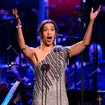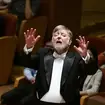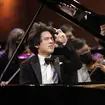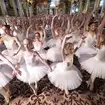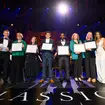The Full Works Concert: Tuesday 24 February 2015, 8pm
Jane Jones continues her survey of the 2014 Classic FM Hall of Fame with Saint-Saens’s dramatic Organ Symphony.
Copland's rousing Fanfare for the Common Man was the brainchild of the conductor Eugene Goossens for the Cincinnati Symphony Orchestra. It was for the 1942 and 1943 seasons that he commissioned several prominent composers to provide concert fanfares, to be played at various subscription concerts across the two years. Among others, Darius Milhaud, Virgil Thomson and Morton Gould all provided works. The 15th fanfare, premiered on 12 March 1943, by Copland, is the only one still in the repertoire today. Copland liked the tune so much he used it just three years later as the theme for the last movement of his Symphony No 3.
Elgar's Variations on an Original Theme for Orchestra, commonly referred to as the Enigma Variations, is a set of 14 variations on a hidden theme that is, in Elgar's words, 'not played'. Elgar dedicated the piece to 'my friends pictured within', each variation being an affectionate portrayal of one of his circle of close acquaintances. The most famous is Nimrod - a variation dedicated to his music editor Augustus J. Jaeger. After its 1899 London premiere, the piece achieved popularity and was performed internationally.
Meet the friends of Elgar who inspired the Enigma Variations >
As the recipient both of the glorious Clarinet Quintet (and the Clarinet Concerto), clarinettist Anton Stadler was truly blessed. Mozart refers to this quintet in his letters as ‘the Stadler quintet’. Written when the composer was 33, it pairs Stadler’s new basset clarinet with a standard string quartet. It was considered by many to be almost a dummy run for the great concerto. Mozart’s effortless writing, combined with some simply inspired tunes, means it is still one of the most widely played works in the repertoire today.
Saint-Saens's Organ Symphony is one of the most technically advanced and sophisticated works of the late 19th century, packed with innovations for the time, and without doubt the pinnacle of the composer's achievements. In it, he introduces the piano as well as the organ producing an ingenious work for four hands alongside the orchestra. The organ’s introduction is especially subtle, and beautifully crafted, whilst the theme itself – based on the old Latin plainchant Dies Irae – is revealed in both major and minor keys throughout the symphony until fully and thrillingly performed by the organist in the closing finale.
Aaron Copland: Fanfare for the Common Man
Carl Davis conducts the Royal Philharmonic Orchestra
Edward Elgar: Variations on an Original Theme
Andrew Davis conducts the Philharmonia Orchestra
Wolfgang Amadeus Mozart: Clarinet Quintet in A major
Clarinet: Emma Johnson
Contempo Quartet
Camille Saint-Saëns: Symphony No.3 in C minor
Organ: Anita Priest
Zubin Mehta conducts the Los Angeles Philharmonic Orchestra




